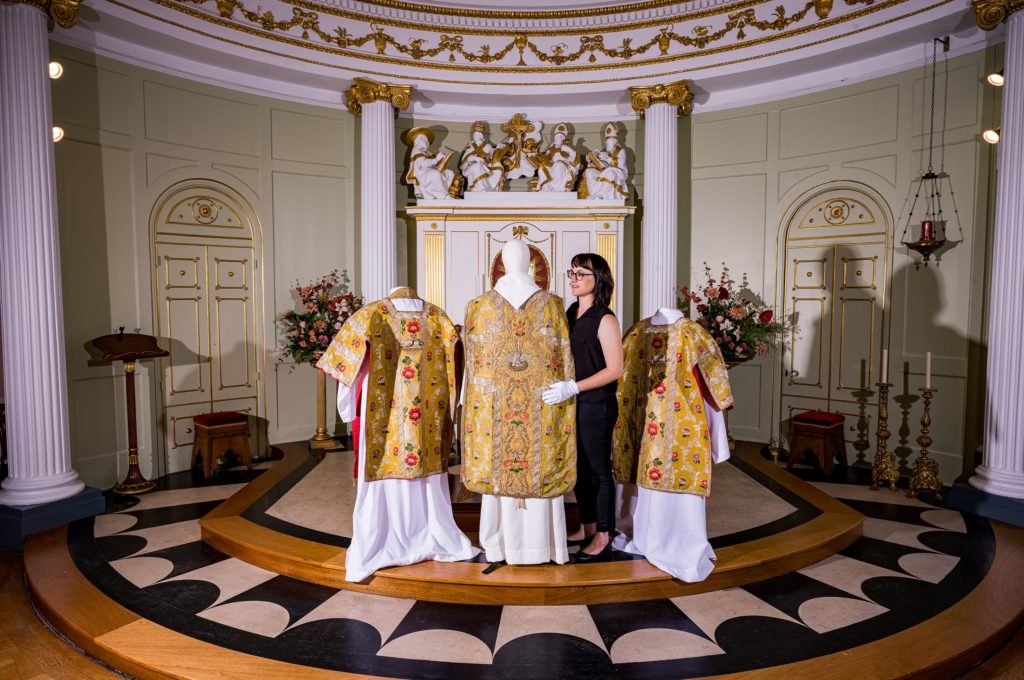
GEORGIAN vestments worn at the Bar Convent’s Opening Illegal Mass are being reunited in the chapel for the first time since 1769 from August 3 to 5 as part of the York Georgian Festival.
Now Great Britain’s oldest living convent, it was established in Blossom Street in 1686 when Roman Catholicism was illegal in this country. The chapel was built in complete secrecy, taking more than 20 years to complete, with the three priest vestments being designed for the inaugural mass, held on April 29 1769.
The vestments were worn together in the chapel only on that occasion. One has since been on display in the Bar Convent Living Heritage Centre’s exhibition; the others have been in the possession of other Roman Catholic churches in York – until now.
Special collections manager Dr Hannah Thomas says: “Historically, these three vestments have been lent to different churches in the city, and it has taken some time to arrange for their return to their original home.
“These incredibly significant vestments were designed and made as a set specifically for the opening of this very special chapel and we are both thrilled and moved to be able to share this historic reunion with the public.”
Hannah continues: “The vestments will be displayed behind the altar in the chapel where they were first worn together more than 250 years ago, at great risk to the priests and all those who attended.
“Not only have these Georgian vestments survived a time in which Catholic material was regularly seized and destroyed, but also the fact that the chapel and the convent have survived against all the odds is an incredible story that we will be highlighting as part of the inaugural York Georgian Festival 2023.”
A private view will be held on August 3 from 5.30pm to 7pm; tickets (£15) can be booked at barconvent.co.uk. Guests are invited to enjoy private access to the house where they can discover the story behind its Georgian architecture, including the secret 18th century chapel. Dr Thomas will give an introduction to the history of the Bar Convent and the vestments; a glass of fizz is included on arrival.
A second ticketed event, Secrecy & Survival: Georgian York Through The Eyes Of A Catholic Convent, will take place on August 5 from 12.30pm to 1.30pm, when the £10 ticket will include admission to the exhibition after the expert talk.
Dr Thomas will explore how the sisters ran an illegal convent under the nose of the authorities without being caught. How did they construct a secret Catholic chapel? What did the rest of York think of what was happening on 18th century Blossom Street? Over to you, Hannah.
Little-known items from the Bar Convent collections will feature as Dr Thomas delves into the archives to find out more.

The Vestments (1769): the back story
DIFFERENT types of priest’s vestments are worn within the Roman Catholic Church. This style is called a chasuble, a sleeveless vestment worn as the top layer by Catholic or High Anglican priests when celebrating Mass.
The shape has varied over time, but this is typical of the 17th and 18th centuries. There is a matching stole too: a narrow, long piece of fabric to be worn underneath the chasuble.
Chasubles often have elaborate embroidery, and these particular vestments are a fine example of 18th century craftmanship. Given that they were made to be worn for the opening of the secret chapel in 1769, the design is befitting of the occasion.
They are handmade with gold threads on a background of silk damask and feature an early use of sequins on liturgical clothing in England.
The icon of the pelican on the back is a direct reference to the pelican on the altar in the Bar Convent chapel. In Roman Catholicism, the pelican is used to symbolise Jesus, as legend has it that the pelican fed its young with its own blood, as Jesus also sacrificed himself for others.
The beautiful flower designs are a symbol of Mary, the mother of Jesus.
York Georgian Festival, August 3 to 6
THIS summer, the glorious Georgians are taking over the city of York.
The fabulous fashions of dashing dandies, extravagant feasting and romantic country dancing add up to the vibrant tale of a golden social scene hidden within the brickwork of York’s abundant 18th century architecture.
In celebration, York Mansion House is collaborating with York museums, venues and historical experts to present York’s first ever Georgian Festival.
Dust off your petticoat and powder your best wig for a plethora of engagements at Fairfax House, Bar Convent and elsewhere. Learn to dance the minuet, discover Georgian family life with Horrible Histories writer Terry Deary, solve the mystery of tricky Dick Turpin’s missing corpse in an immersive murder mystery night and take a peep behind-the-scenes with York’s curators.
For full festival details, head to: mansionhouseyork.com/yorkgeorgianfestival.
